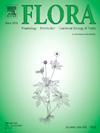Floral nectaries in Spathicarpa hastifolia (Araceae: Spathicarpeae): insights from ultrastructure and biology of the secretory process
IF 1.8
4区 生物学
Q3 ECOLOGY
引用次数: 0
Abstract
The Neotropical tribe Spathicarpeae (Araceae) exhibits unique floral traits, among which staminodes seem to be crucial for reproductive biology in most of its genera. Given the existing gap in the literature on pollination ecology, along with the uncertainties regarding nectar secretion, we studied Spathicarpa hastifolia to describe staminode ultrastructure, investigate secretory processes, and characterize the composition of exudates sought by floral visitors. Flower buds and flowers in different anthesis phases were collected, fixed, and processed for light and electron microscopy. Flowers of S. hastifolia lack a perianth and comprise a gynoecium surrounded by staminodes. Staminodes exude a hyaline fluid during the pistillate and staminate phases of anthesis, attracting floral visitors like cockroaches, ants, and sap beetles. The staminodes are slightly globose, vascularized, and covered by a uniseriate epidermis with widespread stomata that are mostly open pores. The ground tissue is a starch-rich parenchyma whose starch content varies throughout the day due to synthesis and hydrolysis cycles. Chemical analyses showed that staminode exudates constitute sucrose-rich nectar. On the other hand, the fused stamens or synandria exude tiny drops of liquid from their tops, sometimes containing sugars, but in too low concentration to be qualified as nectar. The structure of the secretory cells of staminodes, both from the epidermis and parenchyma, was shown to be compatible with nectar synthesis. Mitochondria, plastids, rough endoplasmic reticulum, and vacuoles prevail in these cells. Altogether, our results show that the staminodes of S. hastifolia are floral nectaries whose secretory activity extends throughout the entire period of anthesis and mediates interactions with potential pollinators.
天南星科Spathicarpa hastifolia的花蜜:分泌过程的超微结构和生物学观察
新热带部落Spathicarpeae(天南星科)表现出独特的花性状,其中雄蕊似乎对其大多数属的生殖生物学至关重要。考虑到传粉生态学文献的空白,以及花蜜分泌的不确定性,我们以Spathicarpa hastifolia为研究对象,描述了花蕊的超微结构,研究了分泌过程,并表征了访花者所寻求的渗出物的成分。收集花蕾和不同花期的花,固定,处理光镜和电镜。花无花被,由雄蕊包围的雌蕊组成。雄蕊在花期的雌蕊期和雄蕊期会分泌出透明的液体,吸引像蟑螂、蚂蚁和树液甲虫这样的来访者。雄蕊稍球形,维管化,被单胚芽表皮覆盖,有广泛的气孔,气孔多为开孔。地面组织是一种富含淀粉的薄壁组织,由于合成和水解循环,其淀粉含量全天都在变化。化学分析表明,雄蕊分泌物构成了富含蔗糖的花蜜。另一方面,融合的雄蕊或双雄蕊从顶部渗出微小的液体,有时含有糖,但浓度太低,不能作为花蜜。雄蕊分泌细胞的结构,无论是来自表皮还是薄壁组织,都显示出与花蜜合成相容。线粒体、质体、粗内质网和液泡在这些细胞中普遍存在。总之,我们的研究结果表明,牡荆的雄蕊是花的蜜腺,其分泌活动贯穿整个花期,并介导与潜在传粉者的相互作用。
本文章由计算机程序翻译,如有差异,请以英文原文为准。
求助全文
约1分钟内获得全文
求助全文
来源期刊

Flora
生物-植物科学
CiteScore
3.30
自引率
10.50%
发文量
130
审稿时长
54 days
期刊介绍:
FLORA publishes original contributions and review articles on plant structure (morphology and anatomy), plant distribution (incl. phylogeography) and plant functional ecology (ecophysiology, population ecology and population genetics, organismic interactions, community ecology, ecosystem ecology). Manuscripts (both original and review articles) on a single topic can be compiled in Special Issues, for which suggestions are welcome.
FLORA, the scientific botanical journal with the longest uninterrupted publication sequence (since 1818), considers manuscripts in the above areas which appeal a broad scientific and international readership. Manuscripts focused on floristics and vegetation science will only be considered if they exceed the pure descriptive approach and have relevance for interpreting plant morphology, distribution or ecology. Manuscripts whose content is restricted to purely systematic and nomenclature matters, to geobotanical aspects of only local interest, to pure applications in agri-, horti- or silviculture and pharmacology, and experimental studies dealing exclusively with investigations at the cellular and subcellular level will not be accepted. Manuscripts dealing with comparative and evolutionary aspects of morphology, anatomy and development are welcome.
 求助内容:
求助内容: 应助结果提醒方式:
应助结果提醒方式:


